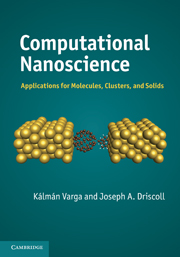Book contents
- Frontmatter
- Contents
- Preface
- Part I One-dimensional problems
- Part II Two- and three-dimensional systems
- 7 Three-dimensional real-space approach: from quantum dots to Bose–Einstein condensates
- 8 Variational calculations in two dimensions: quantum dots
- 9 Variational calculations in three dimensions: atoms and molecules
- 10 Monte Carlo calculations
- 11 Molecular dynamics simulations
- 12 Tight-binding approach to electronic structure calculations
- 13 Plane wave density functional calculations
- 14 Density functional calculations with atomic orbitals
- 15 Real-space density functional calculations
- 16 Time-dependent density functional calculations
- 17 Scattering and transport in nanostructures
- 18 Numerical linear algebra
- Appendix: Code descriptions
- References
- Index
8 - Variational calculations in two dimensions: quantum dots
from Part II - Two- and three-dimensional systems
Published online by Cambridge University Press: 05 June 2012
- Frontmatter
- Contents
- Preface
- Part I One-dimensional problems
- Part II Two- and three-dimensional systems
- 7 Three-dimensional real-space approach: from quantum dots to Bose–Einstein condensates
- 8 Variational calculations in two dimensions: quantum dots
- 9 Variational calculations in three dimensions: atoms and molecules
- 10 Monte Carlo calculations
- 11 Molecular dynamics simulations
- 12 Tight-binding approach to electronic structure calculations
- 13 Plane wave density functional calculations
- 14 Density functional calculations with atomic orbitals
- 15 Real-space density functional calculations
- 16 Time-dependent density functional calculations
- 17 Scattering and transport in nanostructures
- 18 Numerical linear algebra
- Appendix: Code descriptions
- References
- Index
Summary
Introduction
Two-dimensional few-electron systems have been the focus of extensive theoretical and experimental investigation. Recent advances in nanofabrication techniques have enabled experiments with 2D quantum dots having highly controlled parameters such as electron number, size, shape, confinement strength, and magnetic field. The possibility of fabricating these “artificial atoms” with tunable properties is a fascinating new development in nanotechnology. The principal motivations for these investigations are the variety of possible applications in quantum computing [298], spintronics [261], information storage [199], and nanoelectronics [15, 159, 315].
Theoretical calculations of quantum dot systems are based on the effective mass approximation [42, 131, 130, 350, 205, 101, 233, 356, 184, 139, 35, 127]. In these models the electrons move in an external confining potential and interact via the Coulomb interaction. The apparent similarity of “natural” atoms and quantum dots have motivated the application of sophisticated theoretical methods borrowed from atomic physics and quantum chemistry to calculate the properties of quantum dots. Parabolically confined 2D quantum dots have been studied by several different well-established methods: exact diagonalization techniques [131, 205], Hartree–Fock approximations [101, 233, 356], and density functional approaches [184, 139]. Quantum Monte Carlo (QMC) techniques have also been used for 2D [35, 127, 255, 85] as well as 3D structures. The strongly correlated low-electronicdensity regime has received much attention owing to the intriguing possibility of the formation of Wigner molecules [356, 85].
- Type
- Chapter
- Information
- Computational NanoscienceApplications for Molecules, Clusters, and Solids, pp. 196 - 213Publisher: Cambridge University PressPrint publication year: 2011



